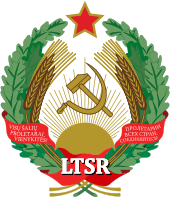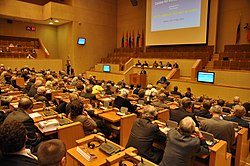| Supreme Soviet of the Lithuanian SSR Lietuvos TSR Aukščiausioji Taryba Верховный Совет Литовской ССР | |
|---|---|
 Coat of arms of the Lithuanian Soviet Socialist Republic Coat of arms of the Lithuanian Soviet Socialist Republic | |
| Type | |
| Type | Supreme Soviet |
| History | |
| Established | 1940 1947 (Re-established) |
| Disbanded | 1941 (Nazi occupation) 1990 (Declaration of independence) |
| Preceded by | People's Seimas |
| Succeeded by | Supreme Council – Reconstituent Seimas |
| Elections | |
| Last election | 1990 |
| Meeting place | |
 | |
| Russian Drama Theatre of Lithuania, Vilnius (1947–1981) Soviet Palace, Vilnius (1981–1990, pictured) | |
The Supreme Soviet of the Lithuanian SSR (Lithuanian: Lietuvos TSR Aukščiausioji Taryba; Russian: Верховный Совет Литовской ССР, Verkhovnyy Sovet Litovskoy SSR) was the supreme soviet (main legislative institution) of the Lithuanian SSR, one of the republics constituting the Soviet Union. The Supreme Soviet was established in August 1940 when the People's Seimas declared itself the provisional Supreme Soviet. According to the constitution it was very similar to modern democratic parliaments: it was elected every four (later five) years and had the power to create, amend and ratify the constitution, laws, and treaties and appoint officials in the Council of Ministers (the executive branch). However, in reality the elections were staged, the Soviet had very little actual power and carried out orders given by the Communist Party of Lithuania (CPL). The situation changed in 1988, when the Lithuanians began seeking independence from the Soviet Union. The political power shifted from CPL to the Soviet, which adopted a number of important constitutional amendments and laws, paving the way for the independence. The first free elections were held in February 1990 and were won by pro-independence Sąjūdis. During its first session the Supreme Soviet adopted the Act of the Re-Establishment of the State of Lithuania and renamed itself the Supreme Council of the Republic of Lithuania.
Organization
The structure and functions of the Supreme Soviet of the Lithuanian SSR were copied from the Supreme Soviet of the Soviet Union. The sessions of the Supreme Soviet lasted only several days twice a year and decisions were made unanimously and without much discussion. Until the dedicated Seimas Palace was completed in 1981, the Soviet gathered at the Russian Drama Theater of Lithuania.
In between the session the Presidium acted on behalf of the Supreme Soviet. The representatives were elected in general elections every four (since 1975 – every five) years. The elections were held in February 1947, February 1951, February 1955, March 1959, March 1963, March 1967, June 1971, June 1975, February 1980, February 1985, and February 1990. All candidates had to be pre-approved by the CPL, which did not allow any members of the opposition to run. The candidates were selected so that each Soviet had the same proportion of social groups; for example, women comprised about a third of the delegates, factory workers about a half. According to official results, voter turnout reached 97.91% during the 1947 elections. Other elections, except for the one in February 1990, were similarly staged. One delegate represented approximately 10,000 people; thus the number of delegates grew from 180 in 1947 to 350 in 1980.
Chairmen of the Supreme Soviet
The chairman of the Supreme Soviet was the presiding officer (speaker) of that legislature.
| Chairman | From | To | Notes |
|---|---|---|---|
| Boleslavas Baranauskas | August 25, 1940 | 1951 | In RSFSR exile 1941–1944 due to World War II |
| Feliksas Bieliauskas | 1951 | 1955 | |
| Vladas Niunka | 1955 | April 18, 1963 | |
| Antanas Barkauskas | April 18, 1963 | December 24, 1975 | |
| Ringaudas Songaila | December 24, 1975 | January 16, 1981 | |
| Lionginas Šepetys | June 1981 | March 10, 1990 | |
| Vytautas Landsbergis | March 11, 1990 | March 11, 1990 | Became chairman of the Reconstituent Seimas |
Presidium of the Supreme Soviet
| Composition of the Supreme Soviet | ||||
|---|---|---|---|---|
| Year | 1967 | 1971 | 1975 | 1980 |
| Number of deputies | 290 | 300 | 320 | 350 |
| Members of CPSU | 67% | 68% | 67% | 67% |
| Factory workers | 51% | 50% | 50% | 50% |
| Women | 32% | 32% | 34% | 35% |
| Youth representatives | 11% | 17% | 20% | 20% |
| With higher education | 42% | 45% | 48% | 51% |
| Re-elected deputies | 31% | 31% | 33% | 30% |
The presidium was the permanent body of the Supreme Soviet. Its chairman was the de jure head of state. The presidium (chairman, two deputy chairmen, secretary, and 13 other members) was elected during the first session of the Soviet. Formally it had great power while the Supreme Soviet was not in session. For example, it could ratify international treaties or amend laws. However, in reality it was a rubber stamp institution for the CPL and de facto head of state was the First Secretary of the CPL.
The chairmen of the presidium were:
| Name | From | To | Notes |
|---|---|---|---|
| Justas Paleckis | August 25, 1940 | April 14, 1967 | In RSFSR exile 1941–1944 due to World War II |
| Motiejus Šumauskas | April 14, 1967 | December 24, 1975 | |
| Antanas Barkauskas | December 24, 1975 | November 18, 1985 | |
| Ringaudas Songaila | November 18, 1985 | December 7, 1987 | |
| Vytautas Astrauskas | December 7, 1987 | January 15, 1990 | |
| Algirdas Brazauskas | January 15, 1990 | March 11, 1990 |
Declaration of independence
Main article: 1990 Lithuanian parliamentary election
The Soviet became an important political battleground since 1988. Inspired and encouraged by perestroika and glastnost, the Lithuanians began taking steps towards independence or at least autonomy from the Soviet Union. The Soviet became the official venue to seek independence in a legal manner. Starting with its 10th session on October 17–18, 1988, the proceedings were televised, hotly debated, and in the center of attention. The political power shifted from the Central Committee of the Communist Party of Lithuania to the Supreme Soviet, which transformed itself from a rubber stamp institution to an actual legislature. In about a year and a half, the Soviet reinstated interwar coat of arms of Lithuania and national anthem Tautiška giesmė, declared superiority of Lithuanian laws over the laws of the Soviet Union, laid groundwork for de-collectivisation, investigated and condemned events surrounding the occupation of Lithuania in 1940, granted religious freedom, adopted citizenship law, enacted new truly democratic election law reducing the number of delegates to 141, abolished political monopoly of the Communist Party allowing other parties to run in the next election. The delegates struggled with changed duties. About 100 of conservative, pro-Soviet delegates did not attend the sessions. Others, accustomed to blindly following orders from top, voted according to the wishes of the presidium and displayed political immaturity. For example, during a vote to appoint Kazimira Prunskienė as a deputy Prime Minister, 100 votes were cast against her during a secret ballot. When the vote was repeated, this time in public, not a single delegate voted against her and only a few abstained. In August 1989, the Soviet announced that the 1939 Molotov–Ribbentrop Pact directly resulted in the Baltics being forcibly incorporated into the USSR in 1940. This marked the first time in the country's history that an official Soviet body challenged the authority of Soviet rule.
In February 1990 elections, when for the first time candidates from the opposition were allowed to run, candidates endorsed by pro-independence Sąjūdis won 96 seats out of 141. During its first three sessions on March 11, 1990, the Soviet elected Vytautas Landsbergis as the chairman and adopted the Act of the Re-Establishment of the State of Lithuania. The same day the Soviet changed its name to the Supreme Council of the Republic of Lithuania. It is also known as Supreme Council – Reconstituent Seimas (Aukščiausioji Taryba – Atkuriamasis Seimas).
The council held its last session on November 11, 1992. It was succeeded by democratically elected Seimas.
References
- Toy parliament until March 1990
- ^ Kamuntavičius, Rūstis; Vaida Kamuntavičienė; Remigijus Civinskas; Kastytis Antanaitis (2001). Lietuvos istorija 11–12 klasėms (in Lithuanian). Vilnius: Vaga. p. 438. ISBN 5-415-01502-7.
- ^ Truska, Liudas (2009). "Aukščiausioji Taryba 1940–1985 metais". Lietuvos Seimo istorija XX–XXI a. pradžia (in Lithuanian). Baltos lankos. pp. 223–225. ISBN 978-9955-23-322-0.
- Jonas Zinkus; et al., eds. (1985). "Aukščiausioji Taryba". Tarybų Lietuvos enciklopedija (in Lithuanian). Vol. I. Vilnius, Lithuania: Vyriausioji enciklopedijų redakcija. pp. 132–133.
- ^ Skirius, Juozas (2002). "Sovietinės Lietuvos valdžios aparato kūrimas". Gimtoji istorija. Nuo 7 iki 12 klasės (in Lithuanian). Vilnius: Elektroninės leidybos namai. ISBN 9986-9216-9-4. Archived from the original on 2008-03-03. Retrieved 2008-02-23.
- Arvydas Anušauskas; et al., eds. (2005). Lietuva, 1940–1990 (in Lithuanian). Vilnius: Lietuvos gyventojų genocido ir rezistencijos tyrimo centras. p. 450. ISBN 9986-757-65-7.
- ^ Jonas Zinkus; et al., eds. (1985). "Aukščiausiosios Tarybos Presidiumas". Tarybų Lietuvos enciklopedija (in Lithuanian). Vol. I. Vilnius, Lithuania: Vyriausioji enciklopedijų redakcija. p. 133.
- ^ Truska, Liudas (2009). "Aukščiausiosios Tarybos evoliucija iš fiktyvios valdžios į parlamentą 1985–1990 metais". Lietuvos Seimo istorija XX–XXI a. pradžia (in Lithuanian). Baltos lankos. pp. 231–253. ISBN 978-9955-23-322-0.
- "Supreme Council (Reconstituent Seimas) 1990–1992". Seimas. 1999-12-07. Retrieved 2008-02-23.
- Legal history of Lithuania
- Government of the Soviet Union
- Government of Lithuania
- 1940 establishments in Lithuania
- 1947 establishments in Lithuania
- Lithuanian Soviet Socialist Republic
- Defunct unicameral legislatures
- 1941 disestablishments in Lithuania
- 1990 disestablishments in Lithuania
- Supreme soviets of the union republics of the Soviet Union